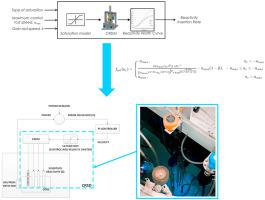当前位置:
X-MOL 学术
›
Prog. Nucl. Energy
›
论文详情
Our official English website, www.x-mol.net, welcomes your feedback! (Note: you will need to create a separate account there.)
Profiling and analysis of control rod speed design on core power control for TRIGA reactor
Progress in Nuclear Energy ( IF 2.7 ) Pub Date : 2020-10-01 , DOI: 10.1016/j.pnucene.2020.103481 Mohd Sabri Minhat , Nurul Adilla Mohd Subha , Fazilah Hassan , Anita Ahmad , Abdul Rashid Husain
Progress in Nuclear Energy ( IF 2.7 ) Pub Date : 2020-10-01 , DOI: 10.1016/j.pnucene.2020.103481 Mohd Sabri Minhat , Nurul Adilla Mohd Subha , Fazilah Hassan , Anita Ahmad , Abdul Rashid Husain

|
Abstract In nuclear reactor TRIGA PUSPATI (RTP) operation, conventional Control Rod Speed Design (cCRSD) uses hard saturation to control rod insertion step as a function of the reactivity insertion rate in the reactor core to ensure the power output will not exceed the limit for the operational safety. The cCRSD which is part of the core power control system produces relatively long settling time during transient and a chattering noise signal during steady-state. Therefore, the current study proposed a new CRSD based on different saturation types such as soft and sigmoid function saturation and changes in the maximum control rod speed limiter value. In this paper, the new CRSD (nCRSD) is designed, profiled, and analyzed based on simulation of an actual Control Rod Drive Mechanism (CRDM) model, common types of saturation models, and reactivity rod worth curve experimental data to predict the best reactivity insertion rate response for operations. The model for core power control is based on mathematical models of the reactor core, the FCA controller, and the CRSD model. The mathematical models of the reactor core are based on a point kinetics model, thermal-hydraulic models, and reactivity models. The nCRSD model is integrated with the Proportional-Integral (PI) type controller and the model of the reactor core. The performance of the nCRSD and cCRSD is compared via computer simulation and experiments. Overall, the results show that the response from the nCRSD offers better results than the cCRSD, which reduces the rise time by up to 52%, the settling time by up to 26%, and the chattering error by up to 25% of the nominal value.
中文翻译:

TRIGA反应堆堆芯功率控制控制棒速度设计分析
摘要 在核反应堆 TRIGA PUSPATI (RTP) 运行中,常规控制棒速度设计 (cCRSD) 使用硬饱和控制棒插入步骤作为反应堆芯中反应插入速率的函数,以确保功率输出不会超过限制操作安全。cCRSD 是核心功率控制系统的一部分,在瞬态期间产生相对较长的稳定时间,在稳态期间产生颤动噪声信号。因此,目前的研究提出了一种新的CRSD,基于软和sigmoid函数饱和等不同的饱和类型以及最大控制棒限速器值的变化。在本文中,基于对实际控制杆驱动机构 (CRDM) 模型、常见类型的饱和模型、和反应棒价值曲线实验数据,以预测操作的最佳反应插入率响应。堆芯功率控制模型基于反应堆堆芯、FCA 控制器和 CRSD 模型的数学模型。反应堆堆芯的数学模型基于点动力学模型、热工水力模型和反应性模型。nCRSD 模型与比例积分 (PI) 型控制器和反应堆堆芯模型集成在一起。通过计算机模拟和实验比较了 nCRSD 和 cCRSD 的性能。总体而言,结果表明 nCRSD 的响应提供了比 cCRSD 更好的结果,将上升时间减少了 52%,稳定时间减少了 26%,颤振误差减少了高达标称值的 25%价值。
更新日期:2020-10-01
中文翻译:

TRIGA反应堆堆芯功率控制控制棒速度设计分析
摘要 在核反应堆 TRIGA PUSPATI (RTP) 运行中,常规控制棒速度设计 (cCRSD) 使用硬饱和控制棒插入步骤作为反应堆芯中反应插入速率的函数,以确保功率输出不会超过限制操作安全。cCRSD 是核心功率控制系统的一部分,在瞬态期间产生相对较长的稳定时间,在稳态期间产生颤动噪声信号。因此,目前的研究提出了一种新的CRSD,基于软和sigmoid函数饱和等不同的饱和类型以及最大控制棒限速器值的变化。在本文中,基于对实际控制杆驱动机构 (CRDM) 模型、常见类型的饱和模型、和反应棒价值曲线实验数据,以预测操作的最佳反应插入率响应。堆芯功率控制模型基于反应堆堆芯、FCA 控制器和 CRSD 模型的数学模型。反应堆堆芯的数学模型基于点动力学模型、热工水力模型和反应性模型。nCRSD 模型与比例积分 (PI) 型控制器和反应堆堆芯模型集成在一起。通过计算机模拟和实验比较了 nCRSD 和 cCRSD 的性能。总体而言,结果表明 nCRSD 的响应提供了比 cCRSD 更好的结果,将上升时间减少了 52%,稳定时间减少了 26%,颤振误差减少了高达标称值的 25%价值。



























 京公网安备 11010802027423号
京公网安备 11010802027423号